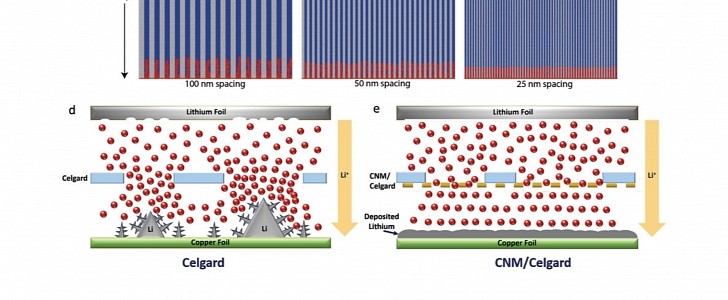If you never heard about dendrites, they are to batteries what kryptonite is to Superman. These needle-like structures form inside lithium-ion cells, perforate the separator, and cause short-circuits, which may lead to fires.
Among lithium-ion cells, lithium metal batteries are among the most promising due to their energy density. Sadly, they are more prone to dendrite forming than other kinds. Researchers have found a clever way to prevent that: with a carbon nanomembrane that controls the flow of lithium ions inside the cells.
The scientists from Friedrich Schiller University in Jena, Boston University (BU), and Wayne State University (WSU) observed that Celgard membranes have irregular pore sizes. In the regions of the membrane where the pores are larger, dendrites tended to form more frequently. The solution was to create a new Celgard membrane with similar pore sizes. The researchers called it a carbon nanomembrane – or CNM, for short. Advanced Energy Materials published their study.
This carbon nanomembrane contains sub-nanometer-sized pores that are way more uniform than those on regular Celgard membranes. It is also so thin that the researchers called it a bidimensional membrane, presenting only width and length.
The scientists then tested similar lithium-metal cells with and without CNM. The ones that had it were charged twice as much as those without it and presented no dendrite formation. What that means is that the cells that had no carbon membrane died in half the time of those with CNM.
Although that seems very promising, it is not clear how this carbon nanomembrane affects the charging speed. With ions having to find their way in more restricted openings, that probably impacted how fast these batteries would be able to get juice. We will try to contact the researchers to learn more about that.
Even if there is a charging speed downside, it is not unlikely that the technology will find its way into production. Electric cars do not rely on fast chargers to move around: they are there for when people cannot recharge at home. Plugging in your electric vehicle where you live allows it to charge much slower and keeps battery packs happy. As much as fast charging may be convenient, it is also bad for these components' health.
The scientists from Friedrich Schiller University in Jena, Boston University (BU), and Wayne State University (WSU) observed that Celgard membranes have irregular pore sizes. In the regions of the membrane where the pores are larger, dendrites tended to form more frequently. The solution was to create a new Celgard membrane with similar pore sizes. The researchers called it a carbon nanomembrane – or CNM, for short. Advanced Energy Materials published their study.
This carbon nanomembrane contains sub-nanometer-sized pores that are way more uniform than those on regular Celgard membranes. It is also so thin that the researchers called it a bidimensional membrane, presenting only width and length.
The scientists then tested similar lithium-metal cells with and without CNM. The ones that had it were charged twice as much as those without it and presented no dendrite formation. What that means is that the cells that had no carbon membrane died in half the time of those with CNM.
Although that seems very promising, it is not clear how this carbon nanomembrane affects the charging speed. With ions having to find their way in more restricted openings, that probably impacted how fast these batteries would be able to get juice. We will try to contact the researchers to learn more about that.
Even if there is a charging speed downside, it is not unlikely that the technology will find its way into production. Electric cars do not rely on fast chargers to move around: they are there for when people cannot recharge at home. Plugging in your electric vehicle where you live allows it to charge much slower and keeps battery packs happy. As much as fast charging may be convenient, it is also bad for these components' health.






